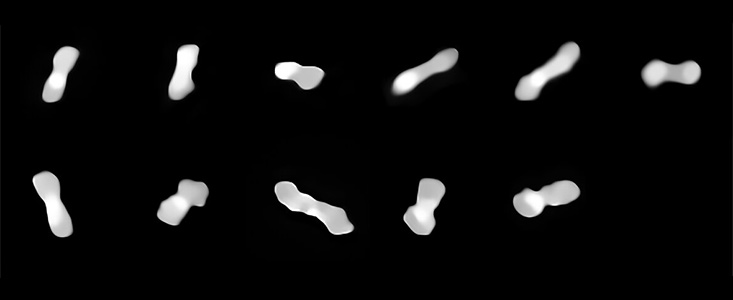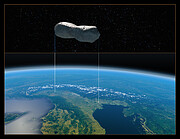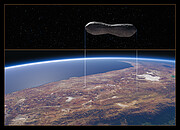Press Release
ESO captures best images yet of peculiar “dog-bone” asteroid
9 September 2021
Using the European Southern Observatory’s Very Large Telescope (ESO’s VLT), a team of astronomers have obtained the sharpest and most detailed images yet of the asteroid Kleopatra. The observations have allowed the team to constrain the 3D shape and mass of this peculiar asteroid, which resembles a dog bone, to a higher accuracy than ever before. Their research provides clues as to how this asteroid and the two moons that orbit it formed.
“Kleopatra is truly a unique body in our Solar System,” says Franck Marchis, an astronomer at the SETI Institute in Mountain View, USA and at the Laboratoire d'Astrophysique de Marseille, France, who led a study on the asteroid — which has moons and an unusual shape — published today in Astronomy & Astrophysics. “Science makes a lot of progress thanks to the study of weird outliers. I think Kleopatra is one of those and understanding this complex, multiple asteroid system can help us learn more about our Solar System.”
Kleopatra orbits the Sun in the Asteroid Belt between Mars and Jupiter. Astronomers have called it a “dog-bone asteroid” ever since radar observations around 20 years ago revealed it has two lobes connected by a thick “neck”. In 2008, Marchis and his colleagues discovered that Kleopatra is orbited by two moons, named AlexHelios and CleoSelene, after the Egyptian queen’s children.
To find out more about Kleopatra, Marchis and his team used snapshots of the asteroid taken at different times between 2017 and 2019 with the Spectro-Polarimetric High-contrast Exoplanet REsearch (SPHERE) instrument on ESO’s VLT. As the asteroid was rotating, they were able to view it from different angles and to create the most accurate 3D models of its shape to date. They constrained the asteroid’s dog-bone shape and its volume, finding one of the lobes to be larger than the other, and determined the length of the asteroid to be about 270 kilometres or about half the length of the English Channel.
In a second study, also published in Astronomy & Astrophysics and led by Miroslav Brož of Charles University in Prague, Czechia, the team reported how they used the SPHERE observations to find the correct orbits of Kleopatra’s two moons. Previous studies had estimated the orbits, but the new observations with ESO’s VLT showed that the moons were not where the older data predicted them to be.
“This had to be resolved,” says Brož. “Because if the moons’ orbits were wrong, everything was wrong, including the mass of Kleopatra.” Thanks to the new observations and sophisticated modelling, the team managed to precisely describe how Kleopatra’s gravity influences the moons’ movements and to determine the complex orbits of AlexHelios and CleoSelene. This allowed them to calculate the asteroid’s mass, finding it to be 35% lower than previous estimates.
Combining the new estimates for volume and mass, astronomers were able to calculate a new value for the density of the asteroid, which, at less than half the density of iron, turned out to be lower than previously thought [1]. The low density of Kleopatra, which is believed to have a metallic composition, suggests that it has a porous structure and could be little more than a “pile of rubble”. This means it likely formed when material reaccumulated following a giant impact.
Kleopatra’s rubble-pile structure and the way it rotates also give indications as to how its two moons could have formed. The asteroid rotates almost at a critical speed, the speed above which it would start to fall apart, and even small impacts may lift pebbles off its surface. Marchis and his team believe that those pebbles could subsequently have formed AlexHelios and CleoSelene, meaning that Kleopatra has truly birthed its own moons.
The new images of Kleopatra and the insights they provide are only possible thanks to one of the advanced adaptive optics systems in use on ESO’s VLT, which is located in the Atacama Desert in Chile. Adaptive optics help to correct for distortions caused by the Earth’s atmosphere which cause objects to appear blurred — the same effect that causes stars viewed from Earth to twinkle. Thanks to such corrections, SPHERE was able to image Kleopatra — located 200 million kilometres away from Earth at its closest — even though its apparent size on the sky is equivalent to that of a golf ball about 40 kilometres away.
ESO’s upcoming Extremely Large Telescope (ELT), with its advanced adaptive optics systems, will be ideal for imaging distant asteroids such as Kleopatra. “I can’t wait to point the ELT at Kleopatra, to see if there are more moons and refine their orbits to detect small changes,” adds Marchis.
Notes
[1] The newly calculated density is 3.4 grams per cubic centimetre, while previously Kleopatra was believed to have a mean density of about 4.5 grams per cubic centimetre.
More information
This research, based on observations with SPHERE on ESO’s VLT (Principal Investigator: Pierre Vernazza), was presented in two papers to appear in Astronomy & Astrophysics.
The team of the paper entitled “(216) Kleopatra, a low density critically rotating M-type asteroid” (https://www.aanda.org/10.1051/0004-6361/202140874) is composed of F. Marchis (SETI Institute, Carl Sagan Center, Mountain View, USA and Aix Marseille University, CNRS, Laboratoire d’Astrophysique de Marseille, France [LAM]), L. Jorda (LAM), P. Vernazza (LAM), M. Brož (Institute of Astronomy, Faculty of Mathematics and Physics, Charles University, Prague, Czechia [CU]), J. Hanuš (CU), M. Ferrais (LAM), F. Vachier (Institut de mécanique céleste et de calcul des éphémérides, Observatoire de Paris, PSL Research University, CNRS, Sorbonne Universités, UPMC University Paris 06 and Université de Lille, France [IMCCE]), N. Rambaux (IMCCE), M. Marsset (Department of Earth, Atmospheric and Planetary Sciences, MIT, Cambridge, USA [MIT]), M. Viikinkoski (Mathematics & Statistics, Tampere University, Finland [TAU]), E. Jehin (Space sciences, Technologies and Astrophysics Research Institute, Université de Liège, Belgium [STAR]), S. Benseguane (LAM), E. Podlewska-Gaca (Faculty of Physics, Astronomical Observatory Institute, Adam Mickiewicz University, Poznan, Poland [UAM]), B. Carry (Université Côte d’Azur, Observatoire de la Côte d’Azur, CNRS, Laboratoire Lagrange, France [OCA]), A. Drouard (LAM), S. Fauvaud (Observatoire du Bois de Bardon, Taponnat, France [OBB]), M. Birlan (IMCCE and Astronomical Institute of Romanian Academy, Bucharest, Romania [AIRA]), J. Berthier (IMCCE), P. Bartczak (UAM), C. Dumas (Thirty Meter Telescope, Pasadena, USA [TMT]), G. Dudziński (UAM), J. Ďurech (CU), J. Castillo-Rogez (Jet Propulsion Laboratory, California Institute of Technology, Pasadena,USA [JPL]), F. Cipriani (European Space Agency, ESTEC - Scientific Support Office, Noordwijk, The Netherlands [ESTEC]), F. Colas (IMCCE), R. Fetick (LAM), T. Fusco (LAM and The French Aerospace Lab BP72, Chatillon Cedex, France [ONERA]), J. Grice (OCA and School of Physical Sciences, The Open University, Milton Keynes, UK [OU]), A. Kryszczynska (UAM), P. Lamy (Laboratoire Atmosphères, Milieux et Observations Spatiales, CNRS [CRNS] and Université de Versailles Saint-Quentin-en-Yvelines, Guyancourt, France [UVSQ]), A. Marciniak (UAM), T. Michalowski (UAM), P. Michel (OCA), M. Pajuelo (IMCCE and Sección Física, Departamento de Ciencias, Pontificia Universidad Católica del Perú, Lima, Perú [PUCP]), T. Santana-Ros (Departamento de Física, Ingeniería de Sistemas y Teoría de la Señal, Universidad de Alicante, Spain [UA] and Institut de Ciéncies del Cosmos, Universitat de Barcelona, Spain [UB]), P. Tanga (OCA), A. Vigan (LAM), O. Witasse (ESTEC), and B. Yang (European Southern Observatory, Santiago, Chile [ESO]).
The team of the paper entitled “An advanced multipole model for (216) Kleopatra triple system” (https://www.aanda.org/10.1051/0004-6361/202140901) is composed of M. Brož (CU), F. Marchis (SETI and LAM), L. Jorda (LAM), J. Hanuš (CU), P. Vernazza (LAM), M. Ferrais (LAM), F. Vachier (IMCCE), N. Rambaux (IMCCE), M. Marsset (MIT), M. Viikinkoski (TAU), E. Jehin (STAR), S. Benseguane (LAM), E. Podlewska-Gaca (UAM), B. Carry (OCA), A. Drouard (LAM), S. Fauvaud (OBB), M. Birlan (IMCCE and AIRA), J. Berthier (IMCCE), P. Bartczak (UAM), C. Dumas (TMT), G. Dudziński (UAM), J. Ďurech (CU), J. Castillo-Rogez (JPL), F. Cipriani (ESTEC), F. Colas (IMCCE), R. Fetick (LAM), T. Fusco (LAM and ONERA), J. Grice (OCA and OU), A. Kryszczynska (UAM), P. Lamy (CNRS and UVSQ), A. Marciniak (UAM), T. Michalowski (UAM), P. Michel (OCA), M. Pajuelo (IMCCE and PUCP), T. Santana-Ros (UA and UB), P. Tanga (OCA), A. Vigan (LAM), O. Witasse (ESTEC), and B. Yang (ESO).
ESO is the foremost intergovernmental astronomy organisation in Europe and the world’s most productive ground-based astronomical observatory by far. It has 16 Member States: Austria, Belgium, Czechia, Denmark, France, Finland, Germany, Ireland, Italy, the Netherlands, Poland, Portugal, Spain, Sweden, Switzerland and the United Kingdom, along with the host state of Chile and with Australia as a Strategic Partner. ESO carries out an ambitious programme focused on the design, construction and operation of powerful ground-based observing facilities enabling astronomers to make important scientific discoveries. ESO also plays a leading role in promoting and organising cooperation in astronomical research. ESO operates three unique world-class observing sites in Chile: La Silla, Paranal and Chajnantor. At Paranal, ESO operates the Very Large Telescope and its world-leading Very Large Telescope Interferometer as well as two survey telescopes, VISTA working in the infrared and the visible-light VLT Survey Telescope. Also at Paranal ESO will host and operate the Cherenkov Telescope Array South, the world’s largest and most sensitive gamma-ray observatory. ESO is also a major partner in two facilities on Chajnantor, APEX and ALMA, the largest astronomical project in existence. And on Cerro Armazones, close to Paranal, ESO is building the 39-metre Extremely Large Telescope, the ELT, which will become “the world’s biggest eye on the sky”.
Links
- Paper 1
- Paper 2
- Photos of the VLT
- For journalists: subscribe to receive our releases under embargo in your language
- For scientists: got a story? Pitch your research
Contacts
Franck Marchis
SETI Institute and Laboratoire d’Astrophysique de Marseille
Mountain View and Marseille, France and USA
Cell: +1-510-599-0604
Email: fmarchis@seti.org
Miroslav Brož
Charles University
Prague, Czechia
Email: mira@sirrah.troja.mff.cuni.cz
Pierre Vernazza
Laboratoire d’Astrophysique de Marseille
Marseille, France
Tel: +33 4 91 05 59 11
Email: pierre.vernazza@lam.fr
Bárbara Ferreira
ESO Media Manager
Garching bei München, Germany
Tel: +49 89 3200 6670
Cell: +49 151 241 664 00
Email: press@eso.org
About the Release
| Release No.: | eso2113 |
| Name: | (216) Kleopatra |
| Type: | Solar System : Interplanetary Body : Asteroid |
| Facility: | Very Large Telescope |
| Instruments: | SPHERE |
| Science data: | 2021A&A...653A..57M 2021A&A...653A..56B |






